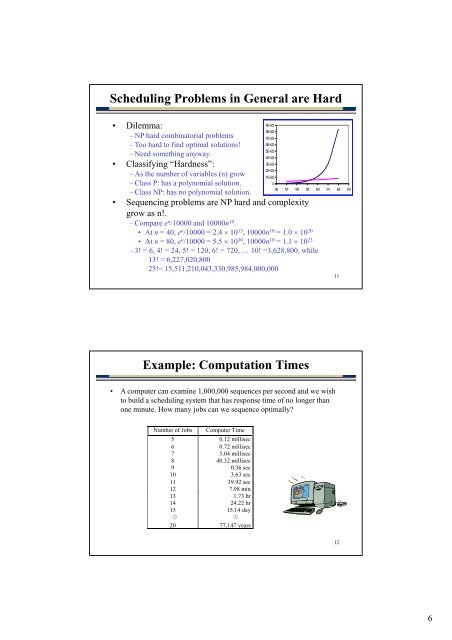Production Scheduling Nahmias, Chapter 8 ( D t lj l i ) (sv ...
Production Scheduling Nahmias, Chapter 8 ( D t lj l i ) (sv ...
Production Scheduling Nahmias, Chapter 8 ( D t lj l i ) (sv ...
Create successful ePaper yourself
Turn your PDF publications into a flip-book with our unique Google optimized e-Paper software.
<strong>Scheduling</strong> Problems in General are Hard<br />
• Dilemma:<br />
– NP hard combinatorial problems<br />
– Too hard to find optimal solutions!<br />
– NNeed dsomething thi anyway.<br />
9E+22<br />
8E+22<br />
7E+22<br />
6E+22<br />
5E+22 5<br />
• Classifying “Hardness”:<br />
3E+22<br />
– As the number of variables (n) grow<br />
– Class P: has a polynomial solution.<br />
– Class NP: has no polynomial solution.<br />
2E+22<br />
1E+22<br />
0<br />
• Sequencing problems are NP hard and complexity<br />
grow as n!.<br />
C /10000 d 10000 10<br />
– Compare en /10000 and 10000n10 .<br />
4E+22<br />
56 57 58 59 60 61 62 63<br />
• At n = 40, e n /10000 = 2.4 × 10 13 , 10000n 10 = 1.0 × 10 20<br />
• At n = 80, e n /10000 = 5.5 × 10 30 , 10000n 10 = 1.1 × 10 23<br />
– 3! = 6, 4! = 24, 5! = 120, 6! = 720, … 10! =3,628,800, while<br />
13! = 6,227,020,800<br />
25!= 15,511,210,043,330,985,984,000,000<br />
Example: Computation Times<br />
• A computer can examine 1,000,000 sequences per second and we wish<br />
to build a scheduling system that has response time of no longer than<br />
one minute. How many jobs can we sequence optimally?<br />
Number of Jobs Computer Time<br />
5 0.12 millisec<br />
6 0.72 millisec<br />
7 5.04 millisec<br />
8 40.32 millisec<br />
9 0.36 sec<br />
10 3.63 sec<br />
11 39.92 sec<br />
12 798 7.98 min i<br />
13 1.73 hr<br />
14 24.22 hr<br />
15 15.14 day<br />
� �<br />
20 77,147 years<br />
11<br />
12<br />
6







